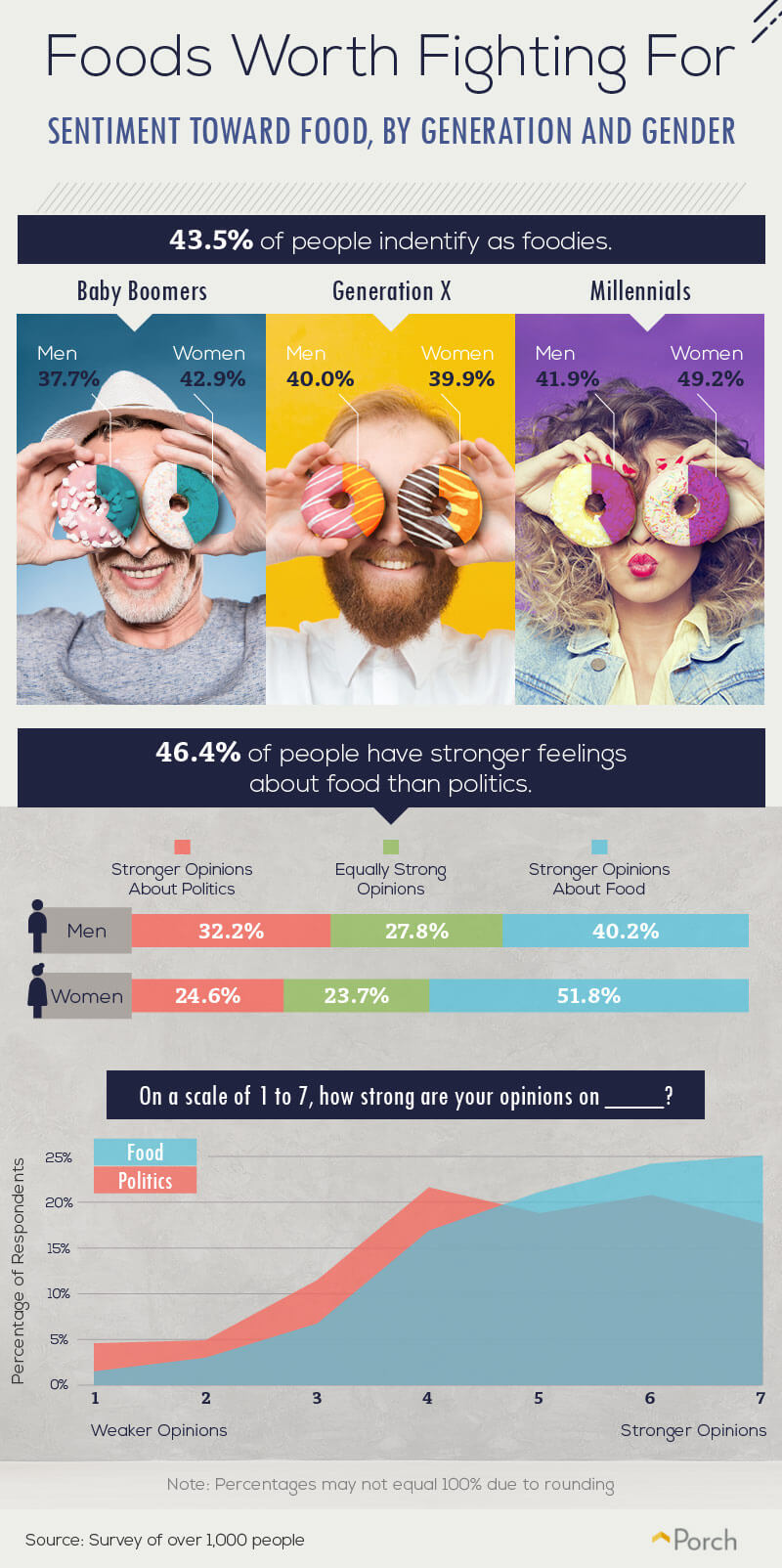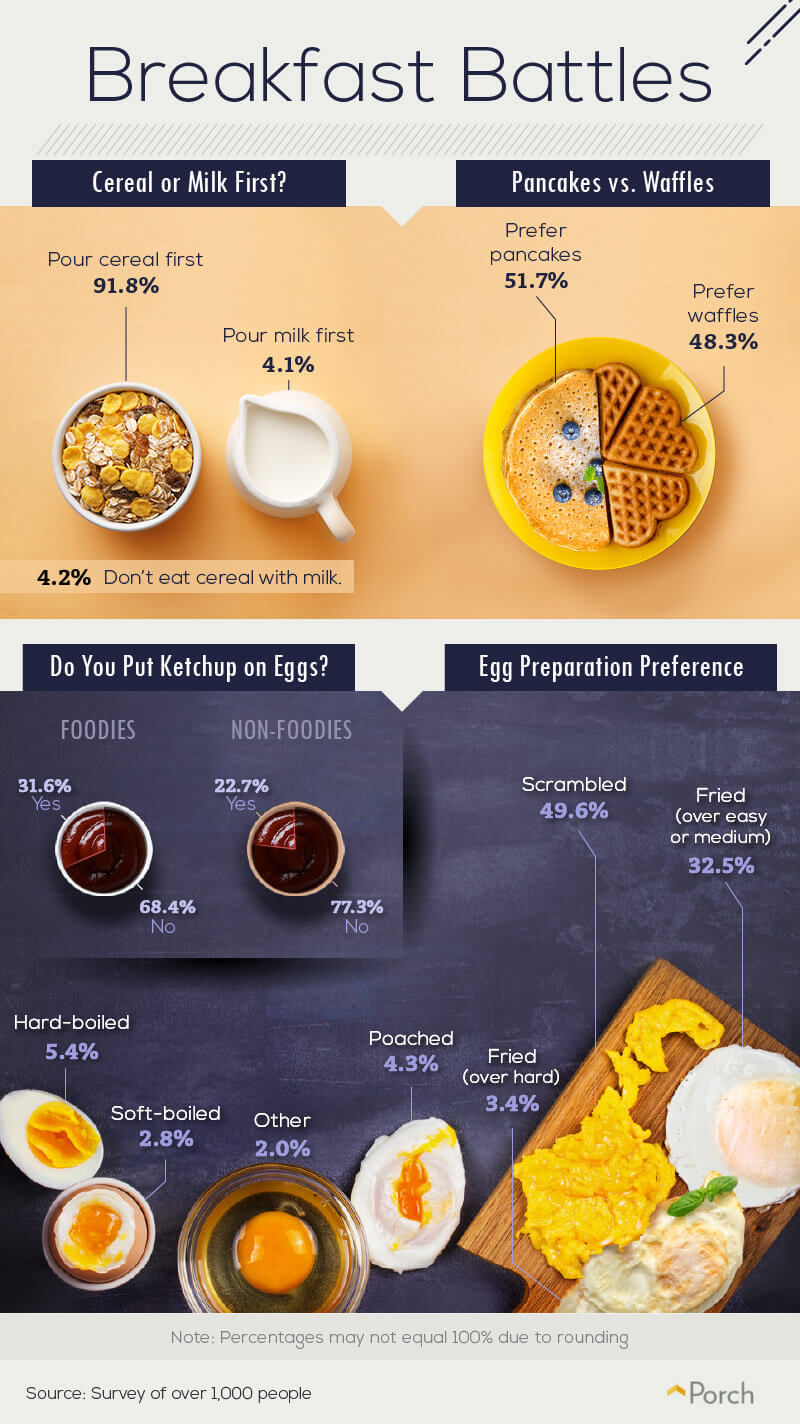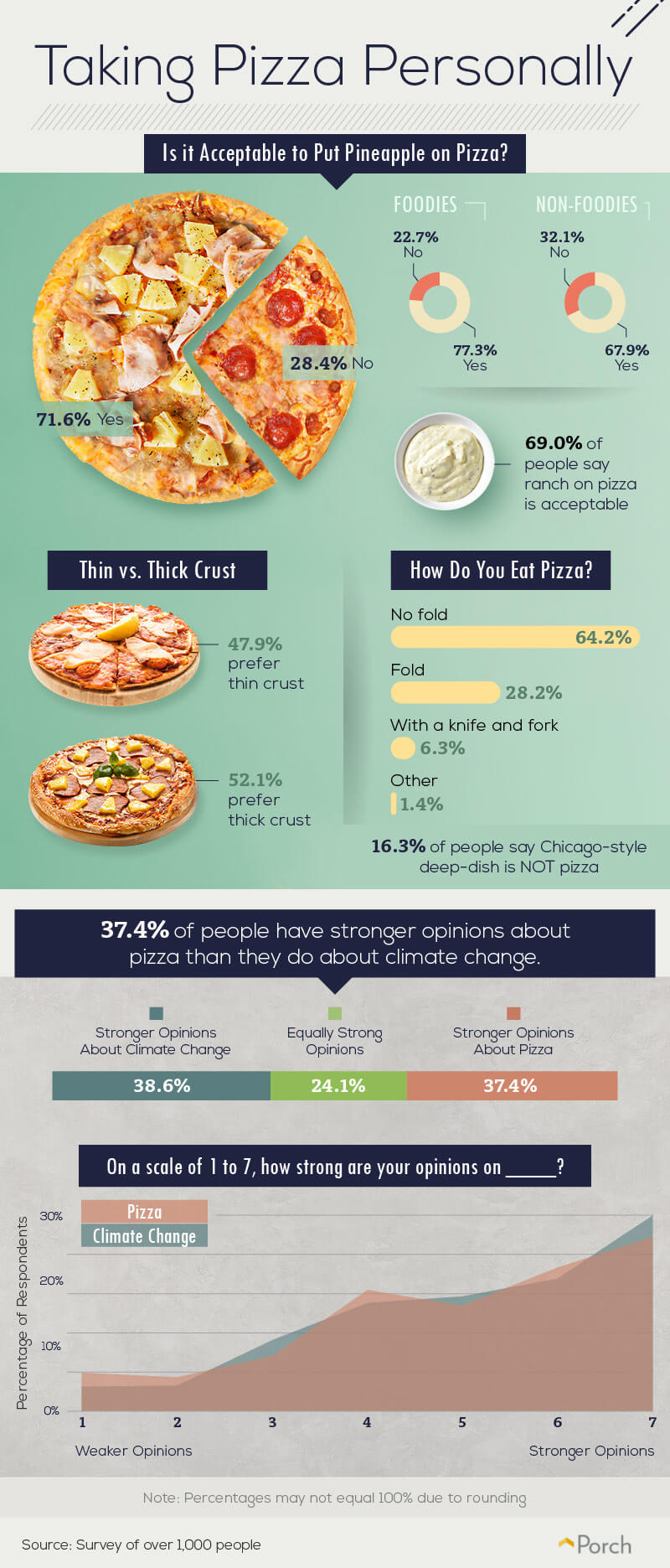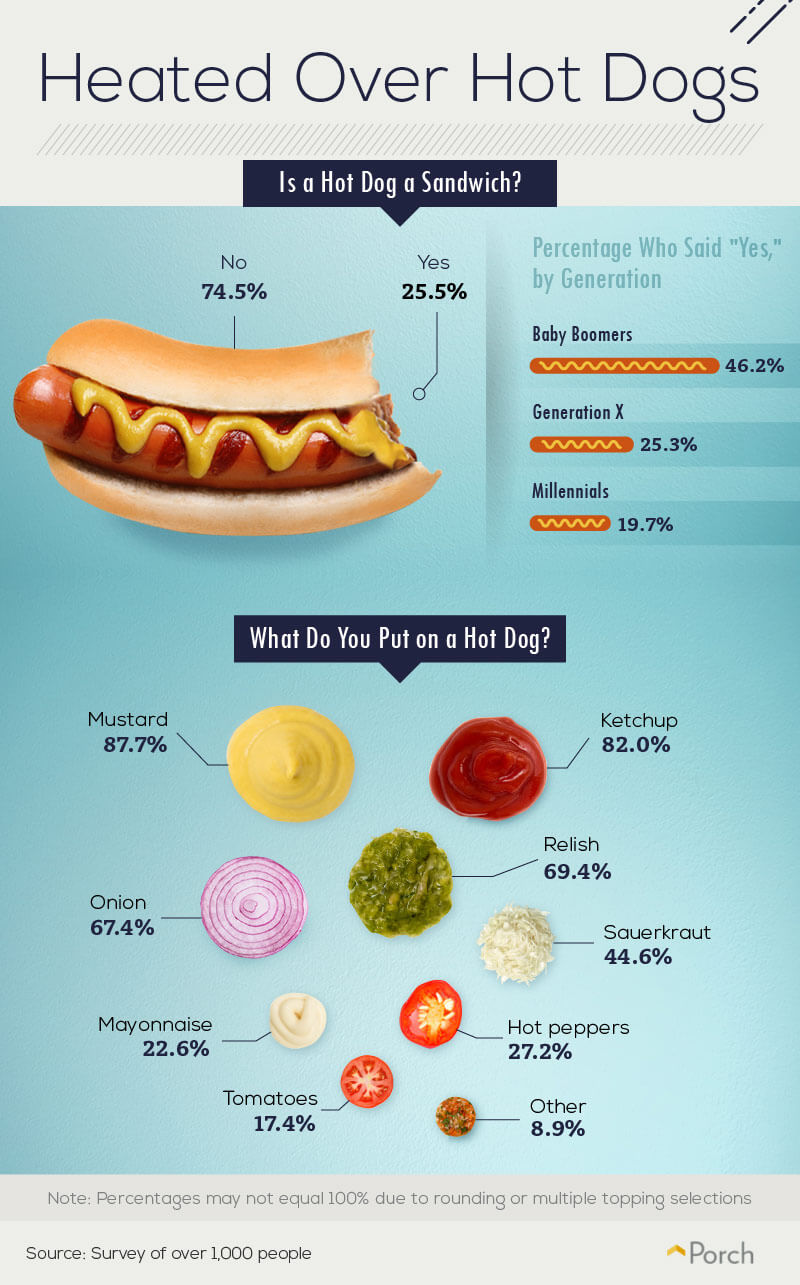
Strong food feelings
 Among all genders and generations we studied, foodies represented a sizeable portion of respondents. Millennials boasted the largest foodie contingent, with nearly half of millennial women claiming to be culinary connoisseurs. Some suggest that millennials’ discerning tastes are driven by their commitment to social media: If you’re going to Instagram your meal, it better be impressive. The habit of dining out can get expensive, however: Members of that generation spend a greater portion of their budgets on food than any other age group. For 46 percent of participants, their feelings about food were more intense than their political convictions. That rate was even higher among women, of whom a majority felt more strongly about food. Plus, when asked to rate the strength of their food-related opinions on a 1-to-7 scale, roughly 25 percent picked the top number. Political feelings were more moderate by contrast—the most frequently picked response was a 4 on our scale.
Among all genders and generations we studied, foodies represented a sizeable portion of respondents. Millennials boasted the largest foodie contingent, with nearly half of millennial women claiming to be culinary connoisseurs. Some suggest that millennials’ discerning tastes are driven by their commitment to social media: If you’re going to Instagram your meal, it better be impressive. The habit of dining out can get expensive, however: Members of that generation spend a greater portion of their budgets on food than any other age group. For 46 percent of participants, their feelings about food were more intense than their political convictions. That rate was even higher among women, of whom a majority felt more strongly about food. Plus, when asked to rate the strength of their food-related opinions on a 1-to-7 scale, roughly 25 percent picked the top number. Political feelings were more moderate by contrast—the most frequently picked response was a 4 on our scale.
The most important meal?
 It can be easy to overlook breakfast in culinary discussions: We tend to defer to familiar staples of the genre. But we found that opinion about those very breakfast essentials could be deeply divided. The classic pancake-waffle debate, for example, yielded nearly an even split, though flapjacks got the slight edge in the end. There was more consensus around the order in which to proceed when preparing milk and cereal. More than 9 in 10 respondents said they pour cereal first and then add milk, and perhaps more surprising, nearly 1 in 20 people eat cereal without any milk at all. The best way to prepare eggs may inspire heated competition among celebrity chefs, but a plurality of our respondents preferred to eat theirs scrambled. Fried eggs were the method of choice for nearly a third of folks, however, while more exotic (and effort-intensive) varieties had relatively few devotees. That being said, the question of whether ketchup was an acceptable addition stirred up some additional disagreement. Though most people opted against doing so, the choice was more common among foodies.
It can be easy to overlook breakfast in culinary discussions: We tend to defer to familiar staples of the genre. But we found that opinion about those very breakfast essentials could be deeply divided. The classic pancake-waffle debate, for example, yielded nearly an even split, though flapjacks got the slight edge in the end. There was more consensus around the order in which to proceed when preparing milk and cereal. More than 9 in 10 respondents said they pour cereal first and then add milk, and perhaps more surprising, nearly 1 in 20 people eat cereal without any milk at all. The best way to prepare eggs may inspire heated competition among celebrity chefs, but a plurality of our respondents preferred to eat theirs scrambled. Fried eggs were the method of choice for nearly a third of folks, however, while more exotic (and effort-intensive) varieties had relatively few devotees. That being said, the question of whether ketchup was an acceptable addition stirred up some additional disagreement. Though most people opted against doing so, the choice was more common among foodies.
The passion of the pie
 Few dishes inspire more regional pride than pizza—and local partisans are more than happy to take a slice out of rival cities’ reputations. In fact, our respondents’ feelings about their pizza were about as intense as their opinions about climate change, and over a third said they cared more about their pie. To be fair, the pizza debate extends to several topics, including how it should be handled. Though New Yorkers are notoriously particular about the “fold hold” method of stuffing a slice down, our results indicate most people prefer to keep it uncreased. Perhaps that’s because folding can be impractical when eating a deep-dish slice. A slim majority preferred the moist and bready thick-crust variety, though 16.3 percent insisted pizza of that kind wasn’t pizza at all. In terms of non-traditional ingredients, we found a healthy majority enjoyed ranch dressing on their pies. Most people also said pineapple was acceptable, a finding sure to offend the sensibility of purist and vocal pineapple pizza critic celebrity chef Gordon Ramsay.
Few dishes inspire more regional pride than pizza—and local partisans are more than happy to take a slice out of rival cities’ reputations. In fact, our respondents’ feelings about their pizza were about as intense as their opinions about climate change, and over a third said they cared more about their pie. To be fair, the pizza debate extends to several topics, including how it should be handled. Though New Yorkers are notoriously particular about the “fold hold” method of stuffing a slice down, our results indicate most people prefer to keep it uncreased. Perhaps that’s because folding can be impractical when eating a deep-dish slice. A slim majority preferred the moist and bready thick-crust variety, though 16.3 percent insisted pizza of that kind wasn’t pizza at all. In terms of non-traditional ingredients, we found a healthy majority enjoyed ranch dressing on their pies. Most people also said pineapple was acceptable, a finding sure to offend the sensibility of purist and vocal pineapple pizza critic celebrity chef Gordon Ramsay.
Hot dog debate
 Turning to another staple of American cuisine, we found plenty of dissent around hot dog preparation and identification. Roughly three-quarters of respondents rejected the notion that hot dogs belong in the pantheon of sandwiches, but baby boomers were most likely to feel they should qualify. One particularly judicious member of that generation, Supreme Court Justice Ruth Bader Ginsburg, recently ruled that the hot dog should belong to the sandwich group. Mustard surpassed ketchup as the most common hot dog condiment, with about 88 percent of people electing to slather on the yellow stuff. More than two-thirds of people employed relish and onions as well. Past that point, however, traditionalist impulses seemed to prevail. More exotic toppings were significantly less popular, with fewer than 30 percent of respondents electing to put hot peppers, mayo, or tomatoes on their dogs.
Turning to another staple of American cuisine, we found plenty of dissent around hot dog preparation and identification. Roughly three-quarters of respondents rejected the notion that hot dogs belong in the pantheon of sandwiches, but baby boomers were most likely to feel they should qualify. One particularly judicious member of that generation, Supreme Court Justice Ruth Bader Ginsburg, recently ruled that the hot dog should belong to the sandwich group. Mustard surpassed ketchup as the most common hot dog condiment, with about 88 percent of people electing to slather on the yellow stuff. More than two-thirds of people employed relish and onions as well. Past that point, however, traditionalist impulses seemed to prevail. More exotic toppings were significantly less popular, with fewer than 30 percent of respondents electing to put hot peppers, mayo, or tomatoes on their dogs.
More culinary customs
 When we picked our respondents’ brain on a range of other contested food topics, we encountered some serious diversity of opinion. Most people preferred a fork to a spoon when consuming macaroni and cheese, but any clear majority opinion ended there. The perfect steak temperature, for instance, prompted quite varied opinions, though medium-rare was the most popular choice. Most people stayed away from the extremes, though President Trump reportedly numbers among the minority who request their meat well-done. On the subject of sweeter eats, more than half of respondents said they were game to dip fries in milkshakes, a union of disparate tastes that appeals to our brains at a molecular level. Meanwhile, the most popular method of popsicle consumption was sucking, and chewy middle brownie pieces triumphed over crispy edge pieces—though only slightly.
When we picked our respondents’ brain on a range of other contested food topics, we encountered some serious diversity of opinion. Most people preferred a fork to a spoon when consuming macaroni and cheese, but any clear majority opinion ended there. The perfect steak temperature, for instance, prompted quite varied opinions, though medium-rare was the most popular choice. Most people stayed away from the extremes, though President Trump reportedly numbers among the minority who request their meat well-done. On the subject of sweeter eats, more than half of respondents said they were game to dip fries in milkshakes, a union of disparate tastes that appeals to our brains at a molecular level. Meanwhile, the most popular method of popsicle consumption was sucking, and chewy middle brownie pieces triumphed over crispy edge pieces—though only slightly.
Taking a stand on snacks
 Snacks can inspire as much strong sentiment as any meal, especially if our routines are rooted in childhood habits. More than 7 in 10 people are peelers of string cheese, for example, though those who bite it instead have aired their case fiercely on Twitter. Then there’s the temperature at which fruit is best consumed, where our respondents were more or less evenly divided. Some fruits can actually lose their taste or texture when stored in the cold, but it’s entirely a matter of discretion with others. Oreo eating methods also vary, with celebrity proponents for some tactics weighing in. Most people just bite in, but about a fifth of people split the cookie first, and another fifth eat the cream separately. Regarding peanut butter, creamy triumphed over crunchy, with more than 60 percent favoring the former. A related internet debate of late centered around Uncrustables, a sealed, crustless PB&J that some have deemed a kind of ravioli. Though many respondents did not know the product, the vast majority who did rejected the ravioli theory.
Snacks can inspire as much strong sentiment as any meal, especially if our routines are rooted in childhood habits. More than 7 in 10 people are peelers of string cheese, for example, though those who bite it instead have aired their case fiercely on Twitter. Then there’s the temperature at which fruit is best consumed, where our respondents were more or less evenly divided. Some fruits can actually lose their taste or texture when stored in the cold, but it’s entirely a matter of discretion with others. Oreo eating methods also vary, with celebrity proponents for some tactics weighing in. Most people just bite in, but about a fifth of people split the cookie first, and another fifth eat the cream separately. Regarding peanut butter, creamy triumphed over crunchy, with more than 60 percent favoring the former. A related internet debate of late centered around Uncrustables, a sealed, crustless PB&J that some have deemed a kind of ravioli. Though many respondents did not know the product, the vast majority who did rejected the ravioli theory.
Your own habits at home
We hope our findings have aroused your own food passions—if you’re craving pizza or Oreos after reading this, you’re in good company. But perhaps our results will also inspire you to give some of the food preferences and practices endorsed by others a try. We get it: When it comes to food, you’re partial to your own habits and favorites. But maybe there’s a reason so many people enjoy ranch dressing on pizza or why some foodies squirt ketchup on their eggs (but never on their hot dogs). If you never try it, you’ll never know. Whatever your own food passions and quirks, don’t let an ugly or impractical kitchen keep you from cooking and eating well. Porch can connect you with trusted home renovation pros in your area, ready to transform your home at affordable rates. To find experts you can count on for any project, explore our site today.
Methodology
To compile the data shown above, we surveyed 1,008 people using Amazon’s Mechanical Turk. The respondents were comprised of 458 men, 549 women, and one who preferred not to answer. The respondent pool included 158 baby boomers, 293 Gen Xers, 544 millennials, and 13 from other generations. While we maintain that the data shown are extremely serious to many, we are, of course, presenting it solely for entertainment purposes.
Fair Use Statement
Like a good pizza, this project is made to share with friends—so long as you do so for noncommerical purposes. If you do use our content and graphics, we simply ask that you link back to this page to attribute us appropriately.
